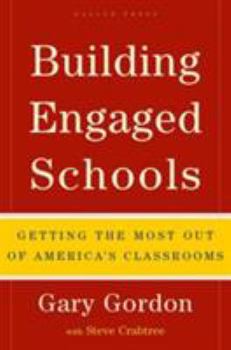Building Engaged Schools: Getting the Most Out of America's Classrooms
Select Format
Select Condition 
Book Overview
Facing greater challenges from increased expectations and global competition, America's public schools can pass the test by thinking and acting differently about selecting teachers and principals, nurturing the talents of students and teachers, and the importance of community involvement. Can America's public schools meet the many challenges they face today? Not by doing what they're doing now, argues Building Engaged Schools -- a book...
Format:Hardcover
Language:English
ISBN:1595620109
ISBN13:9781595620101
Release Date:September 2006
Publisher:Gallup Press
Length:352 Pages
Weight:2.40 lbs.
Dimensions:1.2" x 6.3" x 9.3"
Customer Reviews
4 ratings
Should be on the list of any educator
Published by Thriftbooks.com User , 15 years ago
An excellent book complementing the existing literature. Well-written, deep insight and specific advice - all embedded in theoretical concepts with lots of empirical evidence. Congratulations!
Teachers and students alike will benefit from this process.
Published by Thriftbooks.com User , 17 years ago
America's public schools often rely too heavily on the same old formula for passing success without rising to the challenge of making changes to the system. BUILDING ENGAGED SCHOOLS offers a program for so doing, outlining the many challenges public schools face and covering the different values inherent in 'soft' education activities often ignored in favor of standards and testing processes. Chapters come from a leader of Gallup's Education Division and focuses on how to tap into a child's inner drive and needs to build a classroom program that lifts them from alienation into engagement. Teachers and students alike will benefit from this process. Diane C. Donovan California Bookwatch
It's not limited to schools - all organizations can use this book
Published by Thriftbooks.com User , 17 years ago
Don't be fooled by the title - there is applicability for a variety of organizations, and for profit and not-for-profit groups alike can benefit from Dr. Gordon's outstanding book. With my background and graduate work in education and business, I found myself immediately engrossed in this book and its uses beyond the classroom. I have enthusiastically endorsed this work to several friends and peers in business, education, and healthcare since my recent two-sitting reading of this book. If you are a fan of Carl Rogers, Peter Drucker, Donald Clifton ("How Full Is Your Bucket"), or Marty Seligman, you will love this book. If you have any interest in being part of the revolutionary change needed in corporate America or in the classroom (or school system), you will find yourself fully engaged in this wonderful, well-researched work (up to date with the Gallup organization's 2006 data on the engaged teacher and the engaged workforce). Dr. Gordon's detailed analysis of the six major (faulty) assumptions apply to many workplace situations as they do within the school system. Having previously been a fan of Jonathon Kozol's works, I recall being angry with the situation in many dysfunctional schools systems, but not knowing what, exactly, I could do with that anger. Now I have the material with this book to be part of the solution, both inside and outside of the educational setting. I obviously can't say enough of how much I enjoyed this book.
Data-based, Thoughtful, and Compelling
Published by Thriftbooks.com User , 18 years ago
Gallup's work in the area of strengths is well known and widely used in both the world of business and in many colleges. See, e.g., Now, Discover Your Strengths. This book makes a compelling case for reconciling the competing agendas of No Child Left Behind and the school, student, and teacher-centered approaches by rallying around engagement, for both students and teachers. As usual with Gallup's products, this one is backed up with the surveys and research Gallup has conducted over the years. Neither "engagement" nor "strengths" are left as "soft", unmeasurable terms. Those who want real, measurable improvement in schools and those who want schools to be a great place for teachers and students will find much to like, and perhaps a way to talk to each other in this book. In fact, the three elements that polls in 1995 and 2004 identified as things the public thinks are very important, but not likely to be happening in schools, could be the basis of a great vision statement: * Students challenged to develop themselves to their full potential * Motivated students * Emphasizing the strengths of each student (pp. 62-67). If you're interested in education policy, you need to be conversant with the information and policy recommendations in this book.





